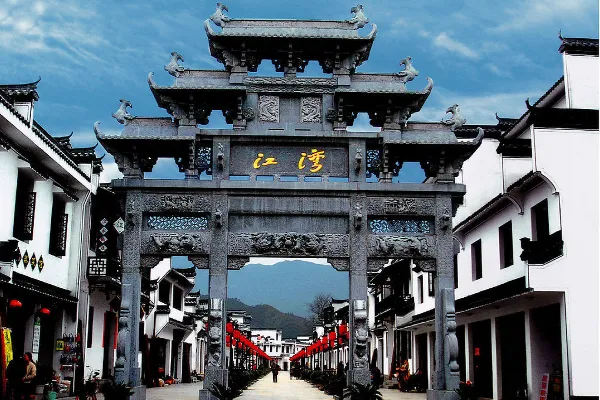
Jiangwan Scenic Area is located in Jiangwan Town, Wuyuan County, Shangrao City, Jiangxi Province. It is a national 5A-level tourist attraction and a famous historical and cultural town in China. The scenic area covers about 27.4 square kilometers, with a core touring area of 3 square kilometers, featuring Huizhou-style ancient architecture and natural ecological landscapes. Established in the Tang Dynasty with over 1,300 years of history, Jiangwan preserves more than 100 ancient buildings from the Ming and Qing dynasties, including ancestral halls, residences, and academies, completely retaining the traditional architectural style and cultural characteristics of Huizhou.
History and Culture
Jiangwan has a long history and profound cultural heritage. In the late Tang Dynasty, the Xiaojiang clan moved here from She County, Anhui to escape war, gradually forming a village. During the Ming and Qing dynasties, Jiangwan flourished as it was located along the important Huizhou-Raozhou ancient route, becoming a commercial center in eastern Wuyuan. Ancient buildings like the Xiaojiang Ancestral Hall and Sanxing Hall witness Jiangwan's glorious past.
Jiangwan is the ancestral home of Neo-Confucianism master Zhu Xi, with relics of the Zhu family still preserved. During the Ming and Qing periods, Jiangwan had a strong scholarly atmosphere, producing 38 imperial examination graduates, earning the title "Land of Literature". The village has many academy and private school ruins, with a rich traditional cultural atmosphere.
Jiangwan's ancient architecture is a typical representative of Huizhou-style buildings, featuring white walls, black tiles, horse-head gables, and exquisite brick, wood and stone carvings. In 2001, Jiangwan was rated as a Chinese Historical and Cultural Town, with its architectural art and cultural value highly recognized.
Main Attractions
Xiaojiang Ancestral Hall
Built during the Wanli period of Ming Dynasty, this is the ancestral hall of the Xiaojiang clan in Jiangwan, covering 2,400 square meters. With three courtyards and five bays, it's grand in scale with exquisite carvings, known as the "First Ancestral Hall in Jiangnan". It preserves precious cultural relics like historical plaques and couplets, serving as an important site for studying Huizhou clan culture.
Sanxing Hall
This was the residence of wealthy merchant Jiang Renjing in Qing Dynasty, covering over 1,000 square meters, named after the owner's daily practice of "self-reflection three times". The complex includes main halls, side rooms, and gardens, with superb brick and wood carvings representing the highest artistic level of Huizhou residential architecture.
Teng Family Old House
Built during Qianlong period of Qing Dynasty, this is a typical Huizhou merchant's residence. The layout follows the "four waters returning to the hall" design, with ingeniously designed courtyards and corridors. The house preserves complete Huizhou-style furniture and daily items, showcasing ancient Huizhou merchants' living scenes.
Jiangwan Ancient Street
The 600-meter-long ancient street is paved with bluestones, lined with shops on both sides. It retains the commercial layout from Ming and Qing periods, with most buildings following the "shop in front, residence behind" pattern, making it a great place to experience ancient commercial culture and buy specialty handicrafts.
Pear Garden
This ecological landscape area covers over 300 acres with thousands of pear trees. Every March when pears blossom, the garden turns snow-white with enchanting scenery. It also has tea gardens and bamboo groves, creating a peaceful and pleasant environment.
Cuisine
Pouch-Style Red Carp
A Wuyuan specialty dish using local red carp stuffed with ingredients like mushrooms and ham, shaped like a pouch. The tender fish and rich broth make it essential for Jiangwan banquets.
Steamed Cake
A traditional Wuyuan snack made from rice batter, with soft and sweet texture. Jiangwan's version adds local wild mugwort for unique fragrance and flavor.
Wuyuan Green Tea
Wuyuan is China's green tea hometown, with tea plantations surrounding Jiangwan. Wuyuan green tea has emerald color, clear aroma and refreshing taste. Enjoying tea in Jiangwan's ancient street teahouses offers special charm.
Surrounding Cuisine
Wuyuan also features dishes like thick soup tofu, steamed pork with rice flour, and fish cooked with fermented rice. County restaurants concentrate authentic Wuyuan rural cuisine with fresh ingredients and unique flavors.
Tickets
Jiangwan Scenic Area ticket price is 60 yuan/person, covering main attractions. Students and seniors can get half-price with valid certificates. Opening hours are 8:00-17:30, with recommended visiting time of 3-4 hours.
Travel Route
Recommended route: Enter through the main gate, first visit Xiaojiang Ancestral Hall to learn history; then explore Sanxing Hall, Teng Family Old House and other ancient residences; have lunch at Ancient Street; stroll and shop for handicrafts in the afternoon; finally enjoy natural scenery at Pear Garden. With more time, visit nearby ancient villages like Xiaoqi and Likeng.
Transportation
- By air: Nearest airport is Jingdezhen Luojia Airport, about 80km from Jiangwan
- By high-speed rail: Take train to Wuyuan Station, then transfer to tourist bus (about 30 minutes)
- By car: From Nanchang via Dechang and Hangrui Expressways, about 3 hours
- Within scenic area: Main attractions are concentrated, walkable
Must-Visit Attractions
- Xiaojiang Ancestral Hall: Top ancestral hall in Jiangnan, representing Huizhou clan culture
- Sanxing Hall: Finest Huizhou residence with exquisite carvings
- Jiangwan Ancient Street: Ming-Qing commercial street, experience ancient market life
- Pear Garden: Snow-like pear blossoms in spring, beautiful ecological landscape
- Teng Family Old House: Typical well-preserved Huizhou merchant residence
Travel Tips
- Best seasons are March-April (pear blossom season) and September-November (pleasant autumn)
- Recommended to allocate half to full day for visit
- Learn about Huizhou culture beforehand for better experience
- Wear comfortable shoes as ancient street stone paths can be slippery
- Try local specialties and buy Wuyuan green tea etc.
- Combine with nearby rapeseed flower views during spring visit
Notes
- Protect ancient architecture, no carving on walls or wooden pillars
- Respect local customs, maintain quiet in ancestral halls
- Keep personal belongings safe in crowded areas
- Be careful when rainy as some alleys are narrow
- Buy specialties at formal shops, check quality
- Be considerate when taking photos